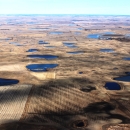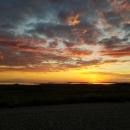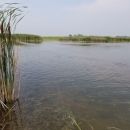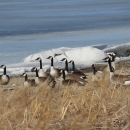About Us
White Lake National Wildlife Refuge is an important feeding and resting area for waterfowl migrating in the Central Flyway. The Refuge provides grassland habitat for sparrows, sharp-tailed grouse, fox, coyote and white-tailed deer; wetland habitat for shorebirds, gulls, terns, rails, and cranes; and island habitat for nesting ducks and Canada geese.
The Refuge is 1,040 acres in size, and has a mix of native grass, tame grass, and rock outcroppings that surround White Lake and other wetlands. White Lake is the largest wetland on the Refuge and is the major oasis in the area for water birds. The lake has an earthen dam with a spillway and a low-level outlet.
Our Mission
Each unit of the National Wildlife Refuge System is established to serve a purpose that targets the conservation of native species dependent on its lands and waters. All activities on those acres are reviewed for compatibility with this purpose.
White Lake National Wildlife Refuge was established “…for use as an inviolate sanctuary, or for any other management purpose, for migratory birds.”
Located within the Central Flyway, the Refuge historically served as a foundation for the restoration of the nearly extirpated giant Canada goose population. Habitat managers strive to restore mixed-grass prairie and provide quality migratory stopover and breeding habitat for birds of conservation concern.
Our History
White Lake National Wildlife Refuge was established through Executive Order 8666 by President Franklin D. Roosevelt “as a refuge and breeding ground for migratory birds and other wildlife”.
The White Lake territory was considered open range for grazing of sheep and cattle prior to 1907. The land that is currently within the boundary of White Lake National Wildlife Refuge was originally homesteaded in 1907 and the grazing of sheep and cattle continued until 1910 when the first farming began.
The original pattern of subsistence farming established by the homesteaders continued until World War I. Following the war, high grain prices encouraged large scale wheat production, and as a result, some tracts of marginal land were brought into crop production. Drought and the Great Depression of the 1930's ended the wheat boom temporarily and initiated another period of subsistence farming.
In 1936, a dam and spillway were constructed on a branch of the North Fork of the Cannonball River, by the Bureau of Biological Survey and the Works Progress Administration (WPA). A secondary (emergency) spillway was completed in 1938. The dam impounded approximately 190 acres of water.
In 1941, the area was established as an Easement Refuge for the protection and preservation of migratory waterfowl, where it remained under easement status until January 1959 when fee title to the first parcel of land was obtained, and the remainder at a later date. This entire area is now vested in the United States as White Lake National Wildlife Refuge.
The name 'White Lake' originated from the fact that the lakebed contains bentonite clay, which has a grayish-white color when dry. The lake averages less than four feet in depth, but provides excellent habitat for migratory birds in an area of North Dakota that has very few natural wetlands.
Other Facilities in this Complex
White Lake National Wildlife Refuge part of the Audubon Wetland Management District. The District manages an array of private and fee-title land held by the U.S. Fish and Wildlife Service.







